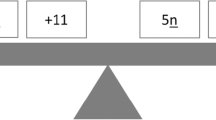Abstract
This paper looks at recent research dealing with uses of the equal sign and underlying notions of equivalence or non-equivalence among preschoolers (their intuitive nitions of equality), elementary and secondary school children, and college students. The idea that the equal sign is a “do something signal”Footnote 1 (an operator symbol) persists throughout elementary school and even into junior high school. High schoolers' use of the equal sign in algebraic equations as a symbol for equivalence may be concealing a fairly tenuous grasp of the underlying relationship between the equal sign and the notion of equivalence, as indicated by some of the “shortcut” errors they make when solving equations.
Similar content being viewed by others
Notes
This expression was first coined by Behr, Erlwanger and Nichols in their 1976 PMDC Technical Report (S. Erlwanger, personal communication, June 1980).
References
Behr, M., Erlwanger, S. and Nichols, E.: 1976, ‘How children view equality sentences’, PMDC Technical Report No. 3, Florida State University. (ERIC Document Reproduction Service No. ED144802).
BrushL. R.: 1978, ‘Preschool children's knowledge of addition and subtraction’, Journal for Research in Mathermatics Education 9, 44–54.
ByersV. and HerscovicsN.: 1977, Understanding school mathematics’, Mathematics Teaching 81, 24–27.
Clement, J.: 1980, ‘Algebra word problem solutions: Analysis of a common misconception’, Paper presented at annual meeting of American Educational Research Association, Boston.
Collis, K. F.: 1974, ‘Cognitive development and mathematics learning’, paper presented at Psychology of Mathematics Education Workshop, Centre for Science Education, Chelsea College, London.
Denmark, T., Barco, E. and Voran, J.: 1976, ‘Final report: A teaching experiment on equality’, PMDC Technical Report No. 6, Florida State University. (ERIC Document Reproduction Service No. ED144805).
Fuson, K. C.: 1979, ‘Counting solution procedures in addition and subtraction’, Paper presented at Wingspread Conference on the Initial Learning of Addition and Subtraction Skills, Racine, Wisconsin.
GattegnoC. 1974, The Common Sense of Teaching Mathematics, Educational Solutions, New York.
GelmanR. and GallistelC. R.: 1978, The Child's Understanding of Number, Harvard University Press, Cambridge.
GinsburgH.: 1977, Children's Arithmetic, Van Nostrand, New York.
HerscovicsN. and KieranC.: 1980, ‘Constructing meaning for the concept of equation’, The Mathematics Teacher 73, 572–580.
Kieran, C.: 1979, ‘Children's operational thinking within the context of bracketing and the order of operations’, in Tall, D. (ed.) Proceedings of the Third International Conference for the Psychology of Mathematics Education, Mathematics Education Research Centre, Warwick University, Coventry, England.
Kieran, C.: 1980, ‘Constructing meaning for non-trivial equations’, Paper presented at annual meeting of American Educational Research Association, Boston. (ERIC Document Reproduction Service No. ED184899).
SiegelL. S.: 1978 ‘The relationship of language and thought in the preoperational child: A reconsideration of nonverbal alternatives to Piagetian tasks’, in SiegelL. S. and BrainerdC. J. (eds.), Alternatives to Piaget, Academic Press, New York.
VergnaudG., BenhadjJ. et DussouetA.: 1979, La Coordination de l'Enseignement des Mathématiques entre le cours moyen 2e année et la classe de sixième, Institut National de Recherche Pédagogique, France.
Author information
Authors and Affiliations
Rights and permissions
About this article
Cite this article
Kieran, C. Concepts associated with the equality symbol. Educ Stud Math 12, 317–326 (1981). https://doi.org/10.1007/BF00311062
Issue Date:
DOI: https://doi.org/10.1007/BF00311062




